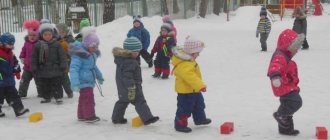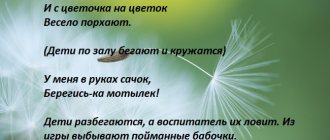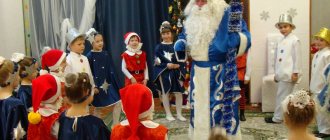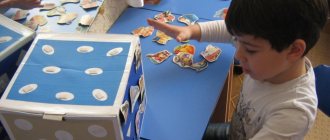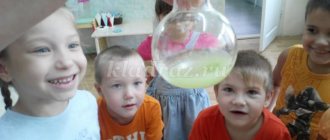Kindergarten lesson notes. Insect life in autumn
Content
Kindergarten lesson notes. Insect life in autumn
Summary of lessons in kindergarten. The world. Middle group.
Topic: “The life of insects in autumn.”
Objectives: To promote the formation of basic concepts about insects. Develop ideas about the adaptation of insects to ongoing changes in nature. Teach children to be careful and take care of insects. Develop an interest in living nature, the ability to see the beauty of nature.
Teaching methods: Playful, demonstration, explanation, questions, reminder, individual approach, assessment.
Preliminary work: Observation. Looking for some insects in the kindergarten area (summer, early autumn).
Individual work: Learn to answer the teacher’s question with a sentence.
Materials and equipment: Insects (rubber toys). Autumn leaves (made of paper), pebbles, stump. Paintings depicting insects (dragonfly, grasshopper, bee, beetle, mosquito).
Progress of the lesson:
The teacher draws the children's attention to the cockerel sitting on the window.
Educator: Children, it seems to me that the cockerel is upset about something, let's ask why he is so sad.
Petushok: I'm very sad because I can't find my friends. In the summer I had a lot of them, but then they all disappeared somewhere.
Question: Who are your friends? Petushok: Now I’ll tell you riddles about them, and you try to guess:
1. From a flower to a blade of grass, From a bush to a path. A spring jumps - a green back.
2. Flies over the meadow, dances, waves a beautiful fan.
3. The busy housewife circles over the colorful lawn. Work on the flower. He will treat her with honey.
4. The airplane is not made of steel. The nose is made with a thin needle. – He flies and squeaks, tries to bite everyone (Mosquito)
Question: Mosquito, bee, butterfly. How can we call them in one word? (Insects).
Petushok: You guessed all my friends correctly, all that remains is to answer the question of where they all disappeared to.
V o p i t a t e l: Children, let's help the cockerel. Now we will go in search of the missing insects.
(Children are invited to look for hidden insects. They find them under leaves, behind bark, under pebbles).
Vopitatel: Guys, where did the insects disappear to? (Insects hid under the bark of trees, in stumps, under stones).
Vopi tatel: That’s right, children, this is how insects survive winter. Because in winter it is cold and there is no lush grass and flowers. And in the spring, when the sun warms up and grass and flowers begin to grow, they will come out of their hiding places and will again delight us with their beauty and cheerful buzzing. (Photos of insects are displayed on the easel). 2-3 children are called, they are asked to show and name the body parts of insects.
Next, children are given cards with images of butterflies, beetles, and dragonflies and are asked to color them.
Vopi t atel: Well done, guys, what beautiful insects you have turned out to be.
Let's give our drawings to the cockerel so that he won't be so sad without his friends. (Children give the cockerel their drawings, the cockerel is carried out the door).
Lesson summary:
Children, what did we do in our lesson? (Children's answers). Where have the insects gone? (They hide in the bark of trees, under leaves, stones).
Copyright © ATTENTION! The website deti-mama.com is protected by copyright law. This material is for personal use only. Copying content and posting on other Internet resources is PROHIBITED.
children-mama.com
We walked around the garden, observing nature
16.10.2017
Quiet, warm, gentle autumn carries withered leaves everywhere, painting them lemon and orange. She sprinkles them on sidewalks, lawns, alleys, not sparing at all...
Autumn is one of the favorable times of the year for observing changes in nature, and you can do them while walking. After all, a walk is always an interesting event for children. This is a source of new experiences and impressions. Autumn bad weather, of course, reduces the time spent outdoors, but cloudy weather is not a reason to stay at home. All you have to do is collect your toys, choose a suitable route, call your friends and you can go for a walk.
On one of the fine October days, the children of the “Kapelka” junior preschool group, kindergarten No. 45, and I took a fascinating, entertaining and educational walk on the topic “We walked around the kindergarten...”, and set off on a fun little train. Moving forward along the paths of the site, the kids said in unison: “In the morning the sky was gloomy, and everything seemed gloomy. Autumn loves to cry and rain on the ground. He loves to rustle leaves and pick them from trees.”
How many exciting, useful, interesting things the kids learned and saw while traveling around the territory of the kindergarten, they gained new knowledge about their surroundings, which caused joyful cries, delight, and surprise among the children. The children clearly saw autumn changes in nature, for example, leaf fall. How interesting it is to watch leaf fall with your children, paying attention to which trees fall off leaves first and which ones last longer, to admire the beauty of leaf fall, saying the words: “The leaves are falling, falling leaves in our garden!” Did you find out why autumn is called “golden”? But why, it turns out, trees put on their autumn attire - answered Semyon Ulas and Masha Ponomareva. Indeed, her outfit is very beautiful and colorful. The leaves of the birch are yellow, and those of the maple are yellow, red, and crimson. At this time of year, the trees celebrate their last ball.
Which tree is the most beautiful? - I asked the children. “Birch tree!”, the kids said in unison, stopped near it, admired its beauty, hugged it tenderly and touched its trunk with their heads. The mountain ash seemed to attract the kids to its branches with red, openwork leaves. How you want to stand under them, the leaves that have survived the wind and rain. And other shrubs attracted the children’s attention with their bright, colorful leaves, making it simply impossible not to stop near them. The most beautiful autumn time! With the arrival of autumn, plant leaves change color. The trees do not all turn yellow at once, they change color one by one, preparing for the winter cold.
Despite the fact that the walk was held on the territory of a kindergarten, you can always see a lot of interesting things here. You just need to help children notice and see all the beauty of the surrounding nature. And here are the flower beds. All summer, the kids and I admired the colors of the flowering plants on them. Autumn has come, the flowers have wilted, but the hardiest flowers, which are not afraid of the cold and rain, still delight and enchant us, adults and children, with their attractive, tempting beauty!
Children walk along the paths, wearing rubber boots and carrying umbrellas in their hands like flowers. Our kids are not afraid of drizzling rain; they want it to rain harder. Standing under an umbrella, they cheerfully shout: “Go, go, rain, let’s cook you borscht!” Porridge for you, and borscht for us, so that it rains harder!” You can’t imagine, puddles are so interesting! This is one of the most attractive places for children! They love to walk through puddles, throw pebbles into them, and measure the depth. “Look how I can do it! And me!” Dima Pesterev, Sasha Kondratyeva and Artyom Prokhorov rejoiced, splashing their boots on the puddle.
Bird watching in autumn is a great pleasure for inquisitive kids. Traveling on a cheerful train along the autumn paths, we did not forget to take with us a treat for the birds: some seeds and a crust of bread, in case we see birds. Indeed, it was as if a flock of pigeons were waiting for us to visit. Having crumbled the bread and poured in the seeds, quietly, as if holding their breath so as not to frighten the birds, the children watched with interest as the birds helped themselves and pecked at the food.
Such a fascinating, memorable event was a walk for our kids. Observations of living and inanimate nature, natural seasonal changes develop children's memory, attention, and cultivate a caring and thoughtful attitude towards the world around them. A child should not mindlessly look at nature, but see and understand natural phenomena and the connection between them. By examining, thinking, comparing, contrasting, the child simultaneously develops speech and thinking. “If you want to teach a child to think logically, take him into nature,” advised the famous Russian teacher and writer K. D. Ushinsky.
Communication with nature instills in a child a sense of beauty. If adults teach a child to admire the bright colors of the sky, the beautiful colors and shapes of leaves, and listen to beautiful sounds in nature, the child will develop a sense of beauty, he will rejoice in beauty and depth, learning about the world around him. Communication with living nature gives a child more vivid ideas than the most beautiful picture book. And how right the famous French philosopher and writer, Fr.
The material was prepared by Tamara Ivanovna Savchuk, teacher of the private educational institution “TsRR “Solikamskbumprom” kindergarten No. 45
Return to News section
“Synopsis of GCD for the senior group “Insects in autumn”
MDOU "Kindergarten No. 25 "Beacon" Frunzensky district of the city of Saratov Summary of direct educational activities on the topic: "Insects in autumn" (using ICT) in senior group No. 1
Prepared by: teacher of the highest category N.A. Gorbacheva Program “Childhood” Senior group “Insects in autumn” Goal: to promote the accumulation of specific ideas about insects. Objectives: To clarify children’s understanding of insects, to be able to isolate their main features (segmented body structure, six legs, the presence of antennae, chitinous cover), to know where the insects have disappeared and where they find refuge. Introduce children to the development cycles of insects. Establish cause-and-effect relationships, the ability to use models in cognitive activity. Develop children’s cognitive activity and observation skills. Develop the ability to compare, highlight common and distinctive features. Foster a caring attitude towards nature and all living things. Working at the computer: Learn to navigate the conditions of a task, plan the course of a solution, provide and evaluate possible options. Orientate yourself in time by arranging events in a certain sequence. Strengthen mouse skills: moving the mouse cursor over table cells, “clicking” on an item, “drag” an item into place
Types of activities: gaming, educational-research, musical Forms of organization: frontal Form of implementation: problem situation Equipment: Multimedia installation. Workbook for children 5 – 6 years old “Welcome to ecology!” part 1. Pencils for each child. Photo illustrations of various insects. Mnemonic table “Insects”. Computer game “What first, what then” (author’s development): Scheme “The development cycle of a butterfly”. Scheme "Ladybug development cycle." Diagram “Dragonfly development cycle.” Mnemonic table based on the poem “Giant” by N. Dymova (compiled together with children). Recording of the song “Autumn” and CD player. Butterflies on magnets. Note: after viewing the required number of slides, the curtain on the multimedia installation closes and the image disappears. The total time for working with the slides is approximately 7 minutes (corresponds to SanPiN). GCD move. 1 part. Children enter the developmental education classroom with the song “Autumn has come.” Talk with children about what time of year it is. Please name the signs of autumn. (Children's answers) I ask the children about insects - what do they do in the fall? (Children's answers) Part 2. Guys, Dunno from our ecology workbook doesn’t know. Let's help him and show him where insects hide for the winter. The children sit at the tables. Work in the workbooks “Welcome to Ecology” for children 5-6 years old (senior group), part 1, page No. 8. Assignment: “Draw a path from each insect to its shelter.” Children complete the task, then tell them that the bark beetle hibernates under the bark of trees for the winter, ants hide in an anthill, ladybugs hide in old stumps, and flies hibernate under fallen leaves. Part 3. Wherever we go - in the garden, in the meadow, in the forest - we are surrounded by insects - our little neighbors. But are they so invisible? Take, for example, an ant - one of them is so small, tiny, you won’t even notice it right away! But in a large anthill there are so many of them that if you measure them in buckets, you will get several buckets!!! (slide No. 1) How many of them are there, like you
schoolfiles.net
Summary of a walk in the preparatory group “Observing the lifestyle of birds in autumn”
Svetlana Romanova
Summary of a walk in the preparatory group “Observing the lifestyle of birds in autumn”
The goal is to clarify children's ideas about the changing lifestyle of birds (domestic and wild)
in the fall ; establish a connection between the weather, changes in the condition of plants and the lifestyle of birds known to children ; to educate children to have a caring and caring attitude towards birds ;
Progress of the walk : Children line up in pairs. The teacher asks the question “Let’s remember what time of year it is?”
- children's answers - “
In autumn it often rains , remember our song about rain?” Children walk, singing the song "Rain"
.
1. Zone 1. The section of the road from the group to the playground . Children form a circle. Teacher: “Guys, remember yesterday we talked about pets? And also about pets....?” - children’s answers – “ birds ”
.
“That’s right, the same type of bird can be both domestic and wild. What kind of birds ? Why are they domestic and wild? Children's answers. (Ducks, geese)
.
Educator: “Now we need to divide into 2 teams: how to do this?”
children offer division options: by 1 and 2, based on
“wild”
,
“domestic”
, and other options.
We choose the appropriate one based on the characteristics of “wild”
and
“domestic”
.
Sedentary game “Who is preparing for winter?”
.
You need to choose a bird (duck or goose)
birds and how wild prepare for winter Teams show each other with gestures, facial expressions, without words, and guess the actions. As the game progresses, the teacher gives the children leading questions about the depiction of movements : what they eat, why there is little food, how this is related to the change in weather, why the family doesn’t fly away. Teacher: “Well done, guys, and now I’ll ask you a riddle:
Guess what kind of bird jumps along the path , as if he is not afraid of cats, collects crumbs,
He wanders around at night, stealing grains. (sparrow)
.
Right. And now, according to the saying “ It’s autumn time, the birds are out of the yard ”
, you turn into a flock of sparrows and fly to the site. Remember how sparrows fly? They don’t scatter to the sides, but sit together in a flock in a safe place; you need to sit in a circle on your area in front of the veranda. So, let's fly.
2. Zone 2. Own site.
D/I “What kind of bird ?”
Goal: to teach children to describe
birds by their characteristic features and recognize them by description. The teacher appoints or selects a leader who describes the characteristic features of the bird ; the children must guess the bird .
3. Zone 3. Sports ground or any free area for active movement.
Outdoor game "Flock"
.Goal: to develop rhythmic and expressive speech;
activate the vocabulary on the topic “
birds ” ;
develop sports skills. Game progress: children choose a driver. New counting rhyme by I. Tokmakova (learning)
:
Sing, sing along, ten birds are a flock.
This bird is a nightingale, this bird is a sparrow, this bird is an owl, a sleepy little head.
This is a waxwing bird, this is a crake bird, this is a starling bird, a gray feather
This bird is a finch, this one is a swift, this one is a cheerful siskin,
Well, this is an evil eagle. Birds, birds, go home! After these words, the children run away, and the driver tries to catch someone. Repeat 2-3 times, focusing on the wishes of the children.
4. Zone 4. Own site. Independent games at will, individual work on the development of movements: in pairs, throwing and catching a ball.
At the end of the walk, work assignments : sweep all play structures , tidy up the sandbox.
5. End of the walk , children go home.
List of used literature:
1. Organization of children’s activities during a walk ( preparatory group )
.T. G. Kobzeva, I. A. Kholodova, G. S. Alexandrova/Volgograd, Teacher, 2013
2. Travel games in the kindergarten area. E. A. Alyabyeva. -Moscow, Sfera shopping center, 2015.
3. Card files of didactic and outdoor games for the preparatory group .
Lesson summary “Insects in autumn. Where do mosquitoes hide for the winter and where do they live?
Children very often ask adults: “Where and how do insects winter?” While playing in the fresh air, taking walks in the park or forest, the children notice that with the onset of cold weather, flies, mosquitoes, butterflies, beetles, dragonflies, ants and other insects have disappeared somewhere.
Parents and teachers can tell children that different insects have many ways to survive winter conditions and survive safely until spring. Not only migratory birds fly south, but also some insects, because they also have wings. For example, migratory butterflies include butterflies (thistles, cabbages, whites, admirals, etc.) and dragonflies (large rocker, watchman). These insects fly long distances, not inferior to birds in this regard. It is interesting that the migratory routes of insects almost coincide with the routes of migratory birds, while butterflies and dragonflies successfully overcome mountain passes (Alps, Pamirs), rising to a height of over five kilometers.
With the onset of cold weather (late autumn and then winter), insects fall into torpor, stop feeding, lose mobility and spend the winter in a state of hidden life. In the spring, they seem to awaken and begin to live as before. They can therefore be called “passive winterers.”
Due to the large number and diversity of insects, we will dwell on only a few of them. Most butterflies (not counting migratory species) die before the onset of winter. But the females leave behind clutches of eggs from which caterpillars develop. Some of them manage to turn into pupae in the summer, others remain to spend the winter in different shelters: some hide in the ground, and others in spider web nests on tree branches. However, among adult butterflies there are wintering ones that do not die, but fall into torpor. These include: urticaria, lemongrass, mourning grass, multiflora, daytime peacock's eye. In late autumn, these butterflies climb under fallen leaves, into cracks in the roots of old stumps, under the bark of trees and in other secluded places. After overwintering, they leave their “shelters” and fly for some time, feeding on plant nectar. Then the females lay eggs and die, and a new generation of butterflies, developing from the eggs (through the caterpillar stage), appears in the second half of summer and flies until autumn. In winter, butterflies of this generation fall into torpor, and in the spring they behave like butterflies of the previous generation.
In winter, beetles and their larvae sleep in a torpored state in various shelters: some - under the bark of half-rotten stumps, others - in cracks in tree trunks, others - in the thickness of wood, etc. Children know a lot of beetles: ground beetles, dung beetles, longhorn beetles, bark beetles, leaf beetles. But the most famous are the May beetles. The appearance of these beetles in the spring occurs suddenly and causes bewilderment in children: where did they come from? Without going into details, we can say that for most of their life (4-5 years) chafers live in the soil in the form of larvae. From year to year, these larvae overwinter, grow, molt, and eventually turn into pupae, from which adult beetles emerge. May beetles and their larvae cause harm by gnawing the roots and foliage of many forest trees. Ladybugs hide between the needles of young pine trees and among the leaves of juniper. In preparation for the coming winter, they tend to hide in advance under the bark of trees, cracks in old wood stumps and other shelters, where they remain in the torpor stage until spring.
Remind children to respect all living things. Don't let them catch and collect butterflies and bugs. We must not forget about the beneficial significance or harmlessness of the existence of animals. For example, butterflies of autumn broods in the caterpillar stage feed on weeds and do no harm, and the butterflies themselves contribute to the pollination of flowering plants. Ladybird beetles and their larvae destroy a lot of aphids that cause harm to many plants.
Dragonflies are also very useful. They catch flies, mosquitoes, midges and other insects, grabbing them in flight. By winter, most dragonflies (excluding migratory species) die, having previously laid eggs in the water. True, the dragonfly does not die, but hibernates and only lays eggs in the spring. The eggs hatch into larvae that live in water for 2-3 years and gradually grow. In the last year of development, the larva turns into an adult dragonfly, the emergence of which occurs in some in the spring, in others in the summer.
Ants dig themselves a shelter from frost at a depth of over a meter, where the temperature always remains at approximately the same level; Having gathered in a large ball, they wait for the onset of warm days.
Bees do not sleep in winter, but become slow and lethargic. In nature, bees settle in tree hollows and rock crevices. They build their nests from wax secreted by special glands. The nests exist for many years, and females and worker bees spend the winter in them. Therefore, honey is stored in wax cells for nutrition, while larvae hatch in others. The role of bees on Earth is extremely great - collecting nectar, they pollinate plant branches, carrying pollen. Without such pollinators, many modern plants would cease to exist.
